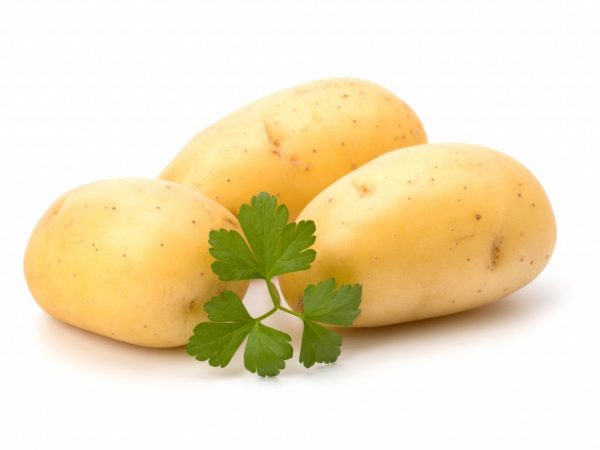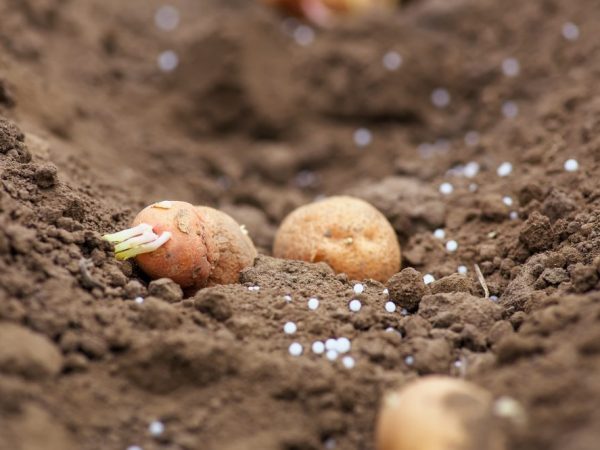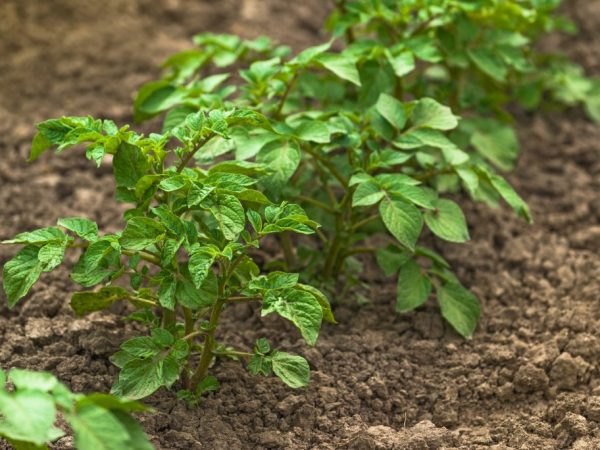Description of potatoes Limonka
One of the best types of nightshade crops is the Limonka potato. It has excellent taste and boils well. The variety is classified as medium late. The first fruits can be eaten 70 days after the appearance of the first shoots, the harvest is ready for storage in 100-120 days.

Description of potatoes Limonka
Plant characteristic
Potato variety Limonka came to us from Holland, where breeders named it Picasso. The name was given for a reason. A description of a potato usually begins with its unusual color. The tubers are painted yellow with pink spots, reminiscent of the artist's whimsical work.
Description of potatoes Limonka:
- tall bush, spreading, with a powerful stem;
- leaves are dark green, medium in size;
- inflorescences are white;
- from one bush, you can collect root crops of a wide variety of sizes;
Description of the fetus
Pear-shaped fruits. The peel is colored light brown or yellow with pink spots. On the cut, the flesh is lemon yellow.
In too arid climates, the fruit takes on a tart flavor. Subject to all agrotechnical rules, the root crops have a pleasant sweetish taste; when heat treated, they boil well. Potato Limonka is used to prepare all sorts of dishes; chips are prepared from it on an industrial scale.
Root crops do not ripen at the same time. The mass of the tuber is on average 100-120 g. From 1 hundred parts it is possible to collect up to 300 kg of root crops. The starch content is reduced, so the roots are well stored.
Benefits
Potato Lemongrass adapts well to any type of soil, but requires a lot of fertilization. Due to the low starch content, potatoes are perfectly stored, resistant to mechanical damage, and therefore can be transported over long distances. One of the main advantages is its excellent taste characteristics.
The variety is classified as medium late, so it perfectly tolerates temperature extremes. Potato Lemongrass is moderately resistant to diseases, often exposed to late blight. It is also susceptible to foliar curling virus.
Growing
Potato variety Limonka is recommended to be planted in open, not ventilated areas. All types of nightshade are photophilous plants, so they give a good harvest only when the bushes are evenly lit from all sides. The ground part of the plant is high, spreading, respectively, the honey step with the holes needs to be done more than for other varieties, about 45-50 cm.
You can grow the potato variety Limonka on any type of soil. The plant responds well to regular fertilization and loosening of the soil. To prevent late blight, it is recommended to follow the rules of crop rotation, that is, do not plant potatoes in the same place for several years in a row, as well as after tomatoes, eggplants, peppers and beets.
Soil preparation

It is advisable to enrich the soil before planting
On the site where it is planned to plant potatoes, it is advisable to plant siderat plants or apply herbicides. In autumn, the soil is dug up to a depth of 30-40 cm and organic fertilizers are applied. Compost, superphosphates, and mineral compositions are used as fertilizers in the fall. If the soil is acidic, dolomite flour is added during this period to ensure a neutral reaction.
In the spring, just before planting, the territory should be dug up again and organic matter added. It is not recommended to use fresh manure, otherwise the taste of the potatoes will suffer. It is important to remember that the cultivation of the soil should be carried out immediately before planting, otherwise the top layer may dry out and then the sprouts will develop poorly. As a fertilizer, fluorine and potassium compounds are used.
Seed preparation
Only smooth tubers are selected for planting, without visible damage and rot. After harvesting, seed material should be landscaped to protect it from rodents. For about a week, the tubers should be left in a warm, bright room, this is how much time it will take for landscaping. Then the seed potatoes are harvested for the winter in a vegetable store.
In the spring, about a month before planting, the seed should be taken out, treated with a solution of manganese or other disinfectant, and germinated. It will take about 4 weeks to germinate. For this, potatoes are left in a dark room at a temperature of 18-20 ℃. After the allotted time, the potatoes must be sorted out and rejected not sprouted.
Landing
You need to plant potatoes when the soil warms up by 4-8 ℃, in early May. Landing is done in the standard way under a shovel. The distance between the holes is 50 cm, between the rows is 70. This will provide good conditions for the full development of spreading, tall bushes.
Onion peels are placed in each hole to protect the plantings from the attack of the wireworm. In addition, before planting, the potatoes are powdered with ash. It is rich in potassium, which plays an important role in the early stages of plant development.
Planting depth will depend on soil density. On light soils, it is customary to plant potatoes to a depth of 10-12 cm, on heavy soils - 5 cm.
Care

Plants need to be fertilized regularly
Potato variety Limonka is considered drought-resistant, but in too hot conditions the yield is much lower. If there is not much rainfall, then watering is carried out every 10 days. The ideal option is a drip system, it will save water resources and provide the root system with sufficient moisture. If watering is carried out in a standard way, water is poured between rows into the furrows formed after hilling.
Stop watering the bushes 20-30 days before harvesting. One of the main conditions for obtaining a good harvest is the timely introduction of fertilizing. In addition, the variety responds well to weeding and hilling. The plant begins to bloom just at the moment the phytophthora progresses, so it is advisable to carry out preventive treatment at the time of the emergence of sprouts 20-30 cm before flowering. Also, for the prevention of late blight, they practice the removal of the lower leaves and shoots when the weather is too humid.
Hilling and weeding
The plantings should be weeded for the first time after 2 weeks. Cultivation is done between rows to a depth of 10 cm, simultaneously removing weeds. When the shoots are strong enough and reach 15 cm, the first hilling is carried out.
21 days after the first hilling, the second is carried out. Loosening is recommended after every rain and watering to avoid the formation of a hard crust on the surface of the soil, which will impede normal air circulation. To preserve moisture in the soil in the southern regions, they practice soil mulching with grass.
Top dressing
The characteristics of the quality indicators of potatoes will significantly improve if all the requirements for fertilization are fulfilled. In addition to applying top dressing during the autumn soil cultivation and during planting, the plants will need to be fed 3 times during the whole season.
Fertilization scheme:
- when the sprouts reach 15 cm, before the first hilling, add urea;
- at the time of budding, a solution of ash or potassium compounds is introduced;
- the last time during the flowering period, nitrophosphates are introduced with chicken droppings or cow dung.
Top dressing is applied in liquid form, right under the bushes. Fertilization is stopped a month before the harvest. Fertilizers should not be overused, especially manure, otherwise the taste of potatoes will be much worse.
Diseases
The culture is resistant to nematode attacks. It has good immunity to:
- scab;
- potato crayfish;
- fusarium and some viral diseases.
Unfortunately, such a type of potato has not yet been bred that would not be attacked by the Colorado potato beetle, as well as fungal diseases. The culture is resistant to late blight of tubers, but the terrestrial part of this disease suffers very often. In areas infected with late blight, the yield is reduced by 70%. At the first symptoms of the disease, the affected parts of the plant should be immediately removed and burned. As a prophylactic agent, you can use Fitosporin, Bordeaux liquid 1% or Tsiram's solution.
The plant often suffers from leaf roll virus. Most often, infection occurs during planting through the seed, so all tubers must be pre-treated. In addition, pests often carry viral diseases. Unfortunately, there is no cure for potato viruses, so prevention must be carried out in a timely manner.
Final part
Potato variety Limonka is a popular crop in many parts of the world. Its excellent taste and high yield do not leave indifferent any potato grower. Among the advantages, gardeners note high resistance to many diseases, good keeping quality and the ability to transport root crops over long distances.
The species is resistant to temperature extremes and unpretentious to the composition of the soil, so it can be planted in any region. Potatoes of this variety are demanding on fertilization, as well as watering. In arid climates, the quality and quantity of the crop decreases.


